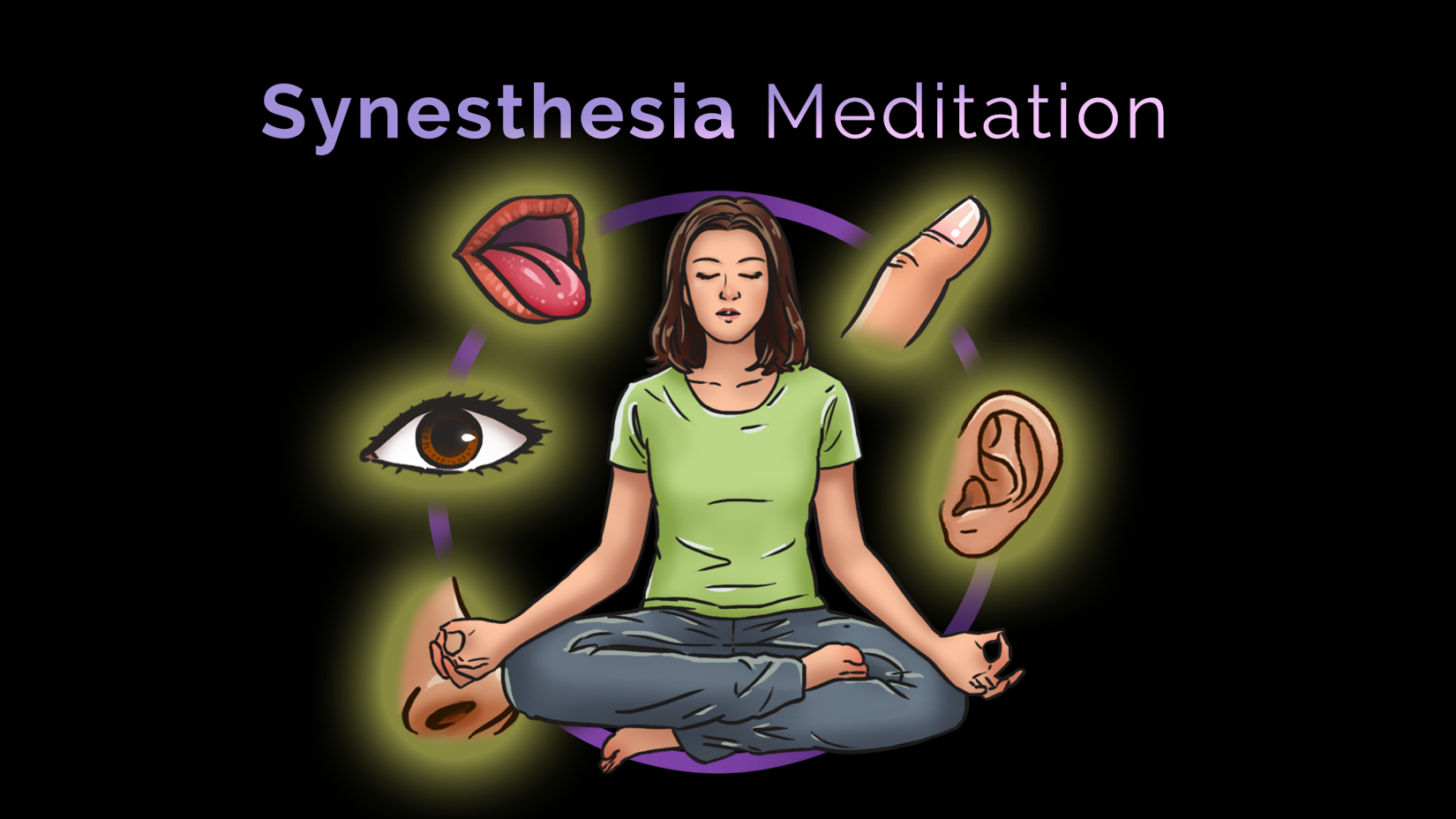What is Synesthesia Meditation?
Increase your mindful synesthetic awareness
Synesthesia Meditation is a mix between synesthetic experiences and traditional mindfulness techniques.
Combined, these techniques they allow to engage more consciously with our senses and hence with our synesthetic perception in daily life.
Synesthesia is a neurological phenomenon, where the stimulation of one sense automatically triggers other senses. People with synesthesia have the ability to see music in shapes and colors. Or they may perceive letters and numbers as colorful personalities.
There are many people that resonate with synesthesia, but most are not aware of it.
Synesthesia requires attention. Mindfulness is the process to shift and sustain attention on internal and external perception.
Mindful synesthetic awareness, is the state of being in the present moment and percieving synesthetic experiences. And Synesthesia Meditation is the practice of achieving that.
Synesthesia Meditation – Becoming aware of synesthetic experiences in daily life.
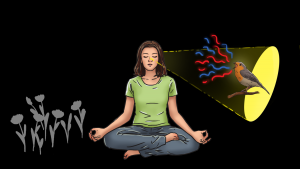
There are many people with synesthesia, but of them may be unaware of their sensory gift.
If you read about synesthesia or watch a movie about it, sometimes they have the impression that synesthetes are experiencing a firework of senses all the time.
This is not quite right.
Synesthesia is subtle and can easy be missed, since you need to shift your attention to it.
For example, if there is background music playing while you are reading a book, you often miss the music. Only if you pay attention to it do you hear the music. The same is true for synesthesia. It requires attention to be perceived.
Our mind distracts us from the synesthetic experiences
Our busy lives distract us from being in the here and now. The mind constantly chatters about the future and the past, seldomly settling into the present moment.
The beauty and the benefits of of synesthesia are easily missed.

For quite a while it was assumed that synesthesia is something rare and special. But this view may be outdated. Synesthesia seems to be more common and many have it. Maybe you too?
If you wish to read more about why some people have a low mindful synesthetic awareness, read our article about it.
Discover, train, apply and integrate Synesthesia
We have created synesthesia meditation to support unconscious synesthetes to discover, train, apply and integrate synesthesia in their daily life.
Studies have shown that meditators are more aware of synesthesia. And it makes sense! Only if you shift your attention onto the perceptions of the present moment and sustain it there, can you become aware of the synesthetic experiences found there.
So how can we become aware of synesthesia? Synesthesia meditation helps you to discover, train, integrate and apply synesthesia in your daily life.
What does this mean?
Discover Synesthesia – there are many different types
In a short survey that we did a few years ago, 70% of synesthetes stated, that they are aware of only 1 to 3 types of synesthesia. There are many different types of synesthesia that you may not have yet discovered yet.
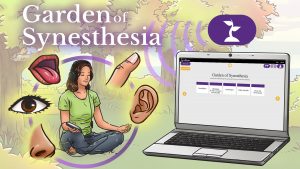
Synesthesia Meditation guides you through the synesthetic world to discover the different types of synesthesia and familiarize with your synesthetic abilities.
In the Garden of Synesthesia it is all about the different forms of Synesthesia.
There you can find different exercises about many types of synesthesia. Discover for example Letter Number Color Synesthesia or Music Synesthesia. In the Sensesphere you will combine all your senses. Taste colors, see touch, and touch odours.
There are also other perceptual aspect of your life you can perceive synesthetically. Emotions, People, Feelings and much more that you may have never before perceived with your mindful synesthetic eye.
So, there is much to discover in the Garden of synesthesia. Check it out here.
Training mindful Synesthesia – it becomes normal and intuitive
As a first step, you discover your synesthetic abilities and the different types of synesthesia. So far so good. The idea is to train your synesthetic abilities on a regular base, to avoid it disappearing again into your subconsciousness.
Establish a routine of doing Synesthesia Meditation every day. It will become intuitive to see the shapes of music, or to smell in shapes, even if you are not meditating. As with many things in life, a constant practise helps you to advance. Your mind will wander less, you will access synesthetic experiences faster and more often.
Training of the mind to shift attention and sustain it.
You may ask, what exactly does “training the mind”mean?
In the Garden of Synesthesia, we discover the different types of synesthesia. On the Path of Mindfulness we practise to shift our attention onto the senses and sustain it there.
With Synesthesia Meditation you train how to shift your mind to your synesthetic experiences, to shift attention from one perception to another and from one synesthetic sense to another and how to do synesthetic loops, You practise how to sustain your attention on your perception, without your mind distracting you, to be in the present moment.
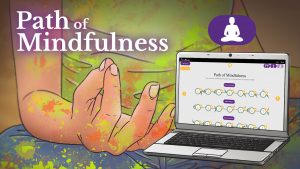
With some training you increase your mindful synesthetic awareness. This is the state in which you are aware of the present moment, without being distracted by your thoughts and your mind. It takes a little bit of practise until your reach a deeper sense of synesthetic mindfulness. But all it needs is your motivation and commitment to complete mindful synesthetic exercises regularly.
The more you do it, the more intuitive synesthesia becomes
The first time you try to see music, it may feel a little weird. Or your thoughts may take over and distract you or overanalyze the exercise, instead of just going with the flow.
The more more exercises you do, the more familiar you get and the easier it becomes to access your synesthetic perceptions. It will become intuitive and less effort will be needed to access your synesthetic experiences in your daily life.
With the practises in the path of mindfulness you also train your mind, to shift your attention and to sustain it on the perceptions in the present moment. You gain the ability to realize when your mind has wandered off and to bring it back to your synesthetic experiences.
Integrating Synesthesia in your daily life
The goal is that you perceive synesthesia in your daily life without using the app. The first step is to do Synesthesia Meditation exercises on a regular base here on synesthesia.com.
After a while you will notice how your increased awareness integrates into everyday life. The techniques transfer intuitively into your present moments..
Many people with synesthesia are kind of inattentional blind to it through their hectic lives.
Integrating synesthesia in your everyday life means, that you experience synaesthetic perceptions wherever you are, whatever you do, even if you are not doing the mindful synesthetic exercises. With a sense of intuition and without effort.
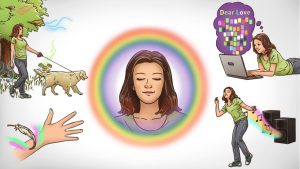
In this way you avoid that synesthesia disappears in your daily life. It helps you to get out more of the present moment, giving yourself short breaks from your chattering mind.
Shift attention to here now and sustain it. Become more engaged with your perceptions.
You will also notice that you increase your resilience to stress and you find more calmness and focus. There are many benefits of doing synesthesia meditation on a daily base.
Applying Synesthesia and benefit of your sensory gift
There are many benefits of being aware of synesthesia and practicing meditation.
Improve cognitive skills such as working memory capacities, focus or creativity.
You may use your synesthetic perception for math or learning vocabulary of different languages.
During the Synesthesia Meditation we give you hints and advice on how you can apply synesthesia for learning tasks.
As you become more familiar with the technique to shift your attention to the present moments’ synesthetic perception, you will find more joy in certain tasks, such as eating or getting a massage.
Being aware of the colors of emotions and perceiving them in a non judgmental way, you gain more control over emotional regulation. See more about this in our article about the benefits of synesthesia and meditation.
Mindfulness – shift and sustain attention on the present moment
Wikipedia describes Mindfulness as following:
“Mindfulness is the psychological process of bringing one’s attention to the internal and external experiences occurring in the present moment, which can be developed through the practice of meditation and other training”.
Kabat Zinn introduced the term “Mindfulness” in the 70s in order to differentiate Mindfulness from Meditation, which is strongly associated with Buddhism.
It has become clear that in our modern world, mindfulness techniques have the potential to reshape our brain and bring many benefits.
Meditation cultivates Synesthesia
Studies have shown that people who meditate report to perceive more synesthetic experiences than a control group that does not meditate. If we train mindfulness, or in other words, rest our attention on the present moment experiences of the, we also become aware of synesthetic experiences.
By adding synesthetic suggestion to the mindfulness practise, the space to explore the senses is created. If these exercises are done on a regular base, then over time, you become aware of synesthesia in your daily life. You automatically start to shift your attention to the colors of the music or the taste of faces.
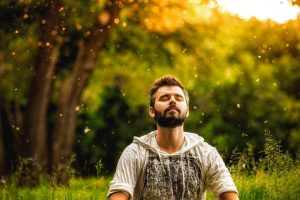
Why Synesthesia Meditation?
Synesthesia and Mindfulness meditation go hand in hand. Synesthesia requires attention to be perceived, consciously. In our hectic work, we easily miss these perceptions. Mindfulness is the state of shifting and sustaining our attention on the perceptions of the present moment.
For synesthetes it is challenging to go on their synesthetic journey alone. Often, they do not know what to do with their sensory gift. And it gets forgotten and buried by the noise of our everyday life.
With a constant practise of synesthesia meditation, you will change that.
The many benefits of Synesthesia Meditation
There have been many studies in the last decades researching the effects and benefits of mindfulness training. There are many benefits of both synesthesia and meditation. Here is a summary of the most important ones:
With a constant practice you will perceive less stress and anxiety, experience more happiness and compassion. You will gain more control over your emotional regulation, and improve your relationships with yourself and others.
There are also cognitive benefits tied to Synesthesia and Meditation. Improved working memory, creativity, and focus are some of them.
Synaesthesia meditation will reshape your brain. There is more to read about the benefits of synesthesia meditation. Click here to learn more about the numerous benefits of Synesthesia and Meditation.
The Sensorium – your sensory awakening space
In the Sensorium you find over 100 exercises, each around 10 minutes in length. With a daily routine you will feel the benefits within a week.
The Sensorium is divided into 3 sections:
![]() In the Garden of Synesthesia, we focus on synesthetic techniques. We discover the different types of synesthesia as we combine the different senses with each other
In the Garden of Synesthesia, we focus on synesthetic techniques. We discover the different types of synesthesia as we combine the different senses with each other
![]() Along the Path of Mindfulness, we train the mind to shift attention to the synesthetic elements of perception and to sustain attention there.
Along the Path of Mindfulness, we train the mind to shift attention to the synesthetic elements of perception and to sustain attention there.
![]() The Gateway is where you find free exercises. No registration needed.
The Gateway is where you find free exercises. No registration needed.
Our techniques within Synesthesia Meditation
To create deep sensory experiences for you, synesthesia consists of a variety of different techniques. We combine different traditional mindfulness techniques with synesthetic experiences. Here you find an overview.

Sensory exploration with synesthetic experiences
In our busy lives, we commonly do not give a lot of attention to our senses. Through the sensory explorations at Synesthesia.com you have the space to go deeper into your perceptual world. As you do it, you will discover the different synesthesias that may be evoked as you focus on your senses.
Drawing synesthetic experiences
When you draw something, you have an extra accurate eye as you notice its details. So, similarly as botanist students draw flowers to become aware of each floral parts, synesthesia meditation is also about drawing. For example in some exercises you will draw shapes, and colors of sound or the arrangement of letters in space.
Synesthetic Loops
Synesthetic loops work like this: when hearing a sound, the sound may trigger a perception of movement, shapes, colors, texture and even smell or taste. A synesthetic loops is shifting your attention from one synesthetic perception to the next. Training to loop through the different types of synesthesia helps you to involve all your synesthetic abilities in any activity, for example while listening to music.
Sensory Loops
To create an overall perceptual experience of you and your surrounding, we practice sensory loops. This means, that we switch between different stimuli and observe what synesthetic experiences are co-activated. For example, listening to a piece of music, we loop through the different instruments and examine the different shapes and colors of it.
Music Series & Nature Sounds
Music and nature sounds provide a great source of synesthetic experiences. We will closely listen to sounds, noise, nature soundscapes and music and become familiar with the different synesthesias you can find there.
Synesthetic Breathing
Focus on the breath is a very traditional mindfulness technique. It trains your mind to sustain attention on a point of focus. The breath is always there. It is a great vehicle on which to rest the mind on and to perceive synesthetic experiences evoked by the breath.
Body scan
Body scans also belong to the classical techniques. You train your attention to shift from one point of focus to the next. It allows you to increase your body awareness. By involving synesthetic suggestions as you scan, you will see that your body provides many opportunities to perceive synesthetic perceptions, .
Sensory scan
The sensory scan is shifting your attention from one sense to the next. It helps you to become more intuitive to perceive the world around you in a holistic context. You learn how to calmly shift your attention from what you smell and taste, to what you see, to what you hear and to the sensations of your skin. Doing that will bring a new, integral dimension into your sensory awareness. For example when you go for a nature walk.
Conclusion
Synesthesia Meditation is a new form of meditation practise. It strengthens your sensory awareness and involves synesthetic experiences. It increases your mindful synesthetic awareness. You will discover, train, integrate and apply synesthesia in your daily life. There are many benefits to gain by doing it.
Now it’s your turn
Practicing Synesthesia Meditation is an time investment in yourself and your happiness. There are many benefits you can gain. Find a time in your day for the 10 minute exercises on a daily base. Stick to that time and build a routine. Make it a ritual! Establishing a new routine is challenging. Given the benefits you will gain, it is completely worth to do it.
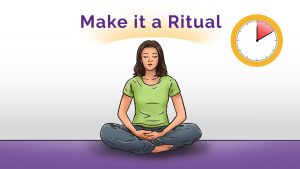
Start your sensory journey today in the sensorium. In the gateway there are over a dozen free exercises for you. You can pick one of the synesthetic exercises. Or if you register, you can save your progress and access your stats.
Click here to get into the Gateway to get started.

